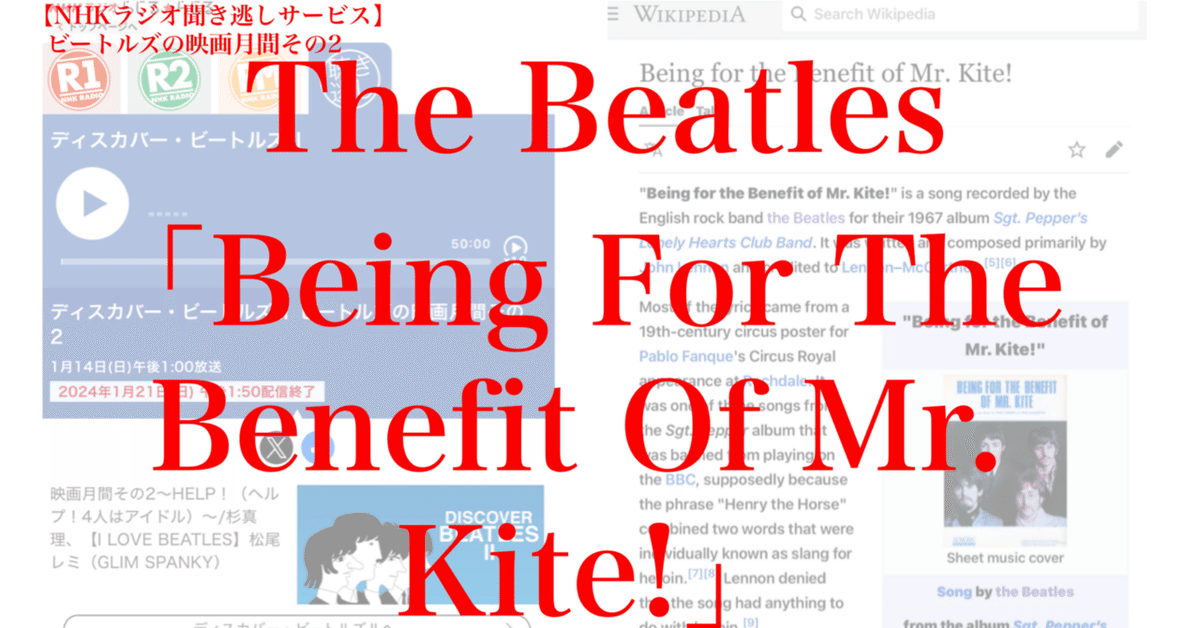
ラジオ生活:ディスカバー・ビートルズ II・ビートルズの映画月間その2・アイ_ラブ_ビートルズ・The Beatles「Being For The Benefit Of Mr. Kite!」
聞き逃しサービス2024/01/14 放送
ディスカバー・ビートルズ II
ビートルズの映画月間その2
アイ_ラブ_ビートルズ
〜
〜
「Being For The Benefit Of Mr. Kite!」
The Beatles
(2分35秒)
〜
開始より24分15秒頃 (終了より25分45秒前頃)
〜
〜
配信終了2024/01/21 13:50
番組情報
Google検索 URL>
https://www.google.co.jp/search?tbm=vid&hl=ja&source=hp&biw=&bih=&q=The_Beatles+Being_For_The_Benefit_Of_Mr_Kite
Bing検索> https://www.bing.com/videos/search?q=The_Beatles+Being_For_The_Benefit_Of_Mr_Kite
TheBeatles.com> https://www.thebeatles.com/being-benefit-mr-kite
「Being For The Benefit Of Mr. Kite!」
Wikipedia EN(英語版)> https://en.m.wikipedia.org/wiki/Being_for_the_Benefit_of_Mr._Kite!
https://en.m.wikipedia.org/wiki/Being_for_the_Benefit_of_Mr._Kite!
〜
"Being for the Benefit of Mr. Kite!" is a song recorded by the English rock band the Beatles for their 1967 album Sgt. Pepper's Lonely Hearts Club Band. It was written and composed primarily by John Lennon and credited to Lennon–McCartney.
Most of the lyrics came from a 19th-century circus poster for Pablo Fanque's Circus Royal appearance at Rochdale. It was one of three songs from the Sgt. Pepper album that was banned from playing on the BBC, supposedly because the phrase "Henry the Horse" combined two words that were individually known as slang for heroin. Lennon denied that the song had anything to do with heroin.
…
【Background】
The inspiration to write the song was a 19th-century circus poster for Pablo Fanque's Circus Royal appearance at Rochdale. Lennon purchased the poster on 31 January 1967 at a Sevenoaks antiques shop while the Beatles were filming promotional films for "Strawberry Fields Forever" in Sevenoaks, Kent. Lennon claimed years later to still have the poster in his home. "Everything from the song is from that poster," he explained, "except the horse wasn't called Henry." (The poster identifies the horse as "Zanthus".)
The song's lyrics (based on the original poster) detail the evening's program, which was to occur at Bishopsgate in the following sequence: On Saturday at 5:50 pm the band was to begin playing while Mr. Kite would perform, flying "through the ring." Meanwhile, Mr. Henderson would execute ten somersaults, and then perform on the trampoline, "over men and horses, through hoops and over garters," and "lastly through a hogshead of real fire." This act would be followed by the Hendersons dancing and singing. Finally, Henry the Horse would dance the waltz.
Mr. Kite is believed to be William Kite, who worked for Pablo Fanque from 1843 to 1845. "Mr. J. Henderson" was John Henderson, a wire-walker, equestrian, trampoline artist, and clown. While the poster made no mention of "Hendersons" plural, as Lennon sings, John Henderson did perform with his wife Agnes, the daughter of circus owner Henry Hengler. The Hendersons performed throughout Europe and Russia during the 1840s and 1850s.
"Being for the Benefit of Mr. Kite!" is credited to Lennon–McCartney, but Lennon said he had written it entirely himself. In 1977, when shown a list of songs Lennon claimed writing on (including "Mr. Kite"), McCartney disputed only "In My Life". In his 1997 memoir, he claimed to have also co-written "Mr. Kite". In a 2013 interview with Rolling Stone magazine, he recalled spending an afternoon with Lennon writing the song based on the poster, and said that "the song just wrote itself".
…
【Recording】
One of the most musically complex songs on Sgt. Pepper, it was recorded by the Beatles on 17 February 1967 with overdubs on 20 February (organ sound effects), 28 March (harmonica, organ, guitar), 29 March (more organ effects) and 31 March. Lennon wanted the track to have a "carnival atmosphere", and told producer George Martin that he wanted "to smell the sawdust on the floor". In the middle eight bars, multiple recordings of fairground organs and calliope music were spliced together to attempt to satisfy this request. In a 1968 interview, Martin recalled that he achieved this "by playing the Hammond organ myself and speeding it up". In addition to the Hammond organ, an attempt was made to find a 19th-century steam organ for hire in London, to enhance the carnival atmosphere effect, but to no avail. After a great deal of unsuccessful experimentation, Martin instructed recording engineer Geoff Emerick to chop the tape into pieces with scissors, throw them up in the air, and re-assemble them at random.
…
…
〜[Excerpted from above wikipedia]
〜[上記wikipediaの日本語翻訳は次の通り。翻訳にはアプリ「DeepL」を使用。]
"Being for the Benefit of Mr. Kite!"は、イギリスのロックバンド、ビートルズが1967年のアルバム『サージェント・ペパーズ・ロンリー・ハーツ・クラブ・バンド』に収録した楽曲。主にジョン・レノンが作詞・作曲し、レノン=マッカートニーにクレジットされている。
歌詞のほとんどは、19世紀にパブロ・ファンクがロッチデールで上演したサーカス・ロイヤルのポスターから引用された。この曲はアルバム『サージェント・ペパー』に収録された3曲のうちの1曲で、「ヘンリー・ザ・ホース」というフレーズが、それぞれヘロインのスラングとして知られていた2つの単語を組み合わせているため、BBCでの演奏が禁止された。レノンはこの曲がヘロインと関係があることを否定した。
…
【背景】
曲作りのきっかけとなったのは、19世紀にロッチデールで行われたパブロ・ファンクのサーカス・ロイヤルのポスターだった。レノンは1967年1月31日、ビートルズがケント州セブノークスで『ストロベリー・フィールズ・フォーエヴァー』のプロモーション・フィルムを撮影していた時に、セブノークスの骨董品店でこのポスターを購入した。レノンは数年後、そのポスターをいまだに自宅に飾っていると主張した。"曲のすべてがあのポスターにある "と彼は説明した。(ポスターでは馬の名前は "ザンサス "となっている)。
この曲の歌詞(オリジナルのポスターが元になっている)には、ビショップスゲートで行われる夜のプログラムが次のような順序で詳しく書かれている:土曜日の午後5時50分にバンドの演奏が始まり、その間にカイトが "輪くぐり "をする。その間にヘンダーソン氏は10回宙返りをし、トランポリンで "人や馬を越え、フープをくぐり、ガーターを越え"、そして "最後に本物の火の入った豚小屋をくぐる"。この演技に続いて、ヘンダーソン一家が踊ったり歌ったりする。最後に馬のヘンリーがワルツを踊る。
カイト氏は、1843年から1845年までパブロ・ファンクの下で働いていたウィリアム・カイトと思われる。「ミスター・J・ヘンダーソン」とは、ワイヤー・ウォーカー、馬術家、トランポリン・アーティスト、道化師のジョン・ヘンダーソンのこと。ポスターには "ヘンダーソンズ "の複数形についての言及はなかったが、レノンが歌っているように、ジョン・ヘンダーソンはサーカス・オーナー、ヘンリー・ヘングラーの娘である妻アグネスと共演していた。ヘンダーソン一家は1840年代から1850年代にかけて、ヨーロッパとロシア全土で公演を行った。
"Being for the Benefit of Mr. Kite!"はレノン=マッカートニー作とクレジットされているが、レノンはすべて自分で書いたと語っている。1977年、レノンが作曲したと主張する曲のリスト(「ミスター・カイト」を含む)を見せられたマッカートニーは、「イン・マイ・ライフ」のみに異議を唱えた。1997年の回顧録では、「Mr.Kite」も共作したと主張している。2013年の『ローリング・ストーン』誌のインタビューでは、レノンと午後を過ごし、ポスターをもとに曲を書いたことを回想し、「曲は自分で書いたんだ」と語っている。
...
【レコーディング】
『サージェント・ペパー』の中で最も音楽的に複雑な曲のひとつであるこの曲は、1967年2月17日にビートルズによってレコーディングされ、2月20日(オルガンの効果音)、3月28日(ハーモニカ、オルガン、ギター)、3月29日(さらにオルガンの効果音)、3月31日にオーバーダビングされた。レノンはこの曲を「カーニバルの雰囲気」にしたかったようで、プロデューサーのジョージ・マーティンに「床のおがくずの匂いを嗅ぎたい」と言った。中間の8小節では、縁日のオルガンとカリオペの複数の録音をつなぎ合わせて、この要望を満たそうとした。1968年のインタビューでマーティンは、「自分でハモンド・オルガンを弾いてスピードを上げることで」これを実現したと回想している。ハモンド・オルガンに加えて、カーニバルの雰囲気効果を高めるために、19世紀の蒸気オルガンをロンドンで借りようと試みたが、効果はなかった。多くの実験に失敗した後、マーティンはレコーディング・エンジニアのジェフ・エメリックに、テープをハサミで切り刻んで空中に放り投げ、ランダムに組み立て直すように指示した。
…
…
〜
